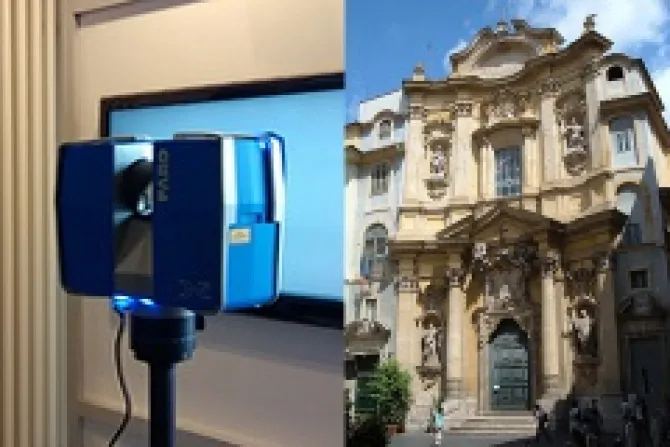Rome, Italy, Jun 15, 2014 / 15:02 pm
Assisting in restoration and reconstruction for artists and architects alike, 3D scanner technology has recently been used to create unique point cloud models of churches and frescoes in Rome.
"The technology of the laser scanner offers great advantages for the technician and the engineer that uses it, especially in terms of the time invested," said Rome-based architect Danilo Prosperi.
"The time it takes to create a model with the 3D laser scanner is drastically reduced in comparison to the technologies that are conventionally used."
Laser scanning has been hailed not only for saving time, but for offering an effective way of approaching ecclesiastic edifices and church decorations such as frescos that photography alone cannot provide.
"Photography is obviously a two-dimensional image, therefore it does not provide information about the dimensionality of the photographed object," Prosperi told CNA. "The laser scanner, instead can obtain, through its photography of reality, a faithful, three dimensional model on the computer."
Prosperi, a scientific researcher who works extensively with the innovative technology, calls this kind of model extremely useful.
"This copy of reality can be used in many different ways and with multiple applications. It produces along with bi-dimensional information, planes, sections and prospects of buildings as well as the analysis of fractured surfaces, the analysis of deformation of surfaces and the three dimensional reconstruction of the edifice in question."
A masters program titled "Architecture, Sacred Art and Liturgy" at the European University of Rome specializes in this 3D scanning of ecclesiastical surfaces.
But this is not the only innovative approach to architecture in the masters program. The professors want to help the students to deepen their understanding of architecture itself.
"The Master puts a specific emphasis on the field of ecclesiastical patrimony, through a new approach. It tries to look at the beauty of architecture through the eyes of the ancient architects," Prosperi explains.
"The unity of wisdom of antiquity, the 'Quadrivium,' which is geometry, arithmetic, music and astronomy, are offered to our students as instruments in order for them to discover the beauty of architecture. All are taken together as a unity."
Multiple projects have already been completed, such as models of excavations of ancient towns and city squares, monumental edifices, castles, ancient walls and churches. Among them, the splendid Rococo church S. Maria Maddalena right next to the Pantheon in the heart of Rome.
"In this church of the Maddalena we have worked in the main naves, as well as in the Rococo-sacristy for restoration purposes in the past year," he said.
The 3D model of the church helps to single out cracks not visible through conventional methods.
"It was necessary to make a new set of 3D models in order to analyze the fracturing of a wall that was restored already a couple of years back."
"From the analysis of the deformation of the frescoed wall it was possible to see that there was a four centimeter change and deformation. A new restoration was therefore initiated to fix the problem."



